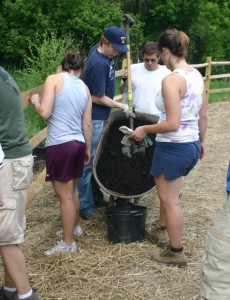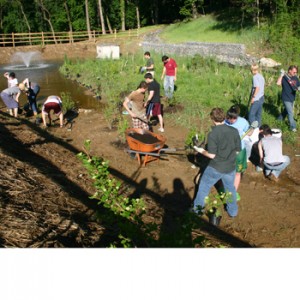Alec Bernstein ’11 (Colts Neck, N.J.) spent much of the spring semester planting trees, shrubs, and wildflowers in a small wetland area in Easton’s Sullivan Park, just north of the College. This summer, he has been installing and monitoring a gauging station that keeps track of the height of the water in the wetland—and helps determine whether the vegetation is helping control water runoff.

“Controlling the runoff is important in limiting the impact that development has on the environment,” says Bernstein, a civil and environmental engineering major who assisted David Brandes, associate professor of civil and environmental engineering, during an independent study in the spring and as an EXCEL Scholar this summer.
Bernstein is one of dozens of Lafayette students and local volunteers who have worked on the project since its inception in 2005. A junior design project team came up with the conceptual design, a group of hydrology students developed a monitoring plan last fall, and a new group of junior design students and volunteers from the Bushkill Stream Conservancy (BSC) helped with the plantings and with pulling non-native, invasive plants.
Brandes says the project grew from discussions he had with Pennsylvania Rep. Bob Freeman and members of the BSC in 2005, following Hurricane Ivan. The BSC then formed a partnership with the City of Easton and secured several Growing Greener grants from the Pennsylvania Department of Environmental Protection. The first grant, in 2007, enabled the group to hire a professional engineering firm, which completed its work in 2008. A second grant paid for materials and equipment for planting and monitoring.
“The design is based on the idea of expanding the existing small wetland in Sullivan Park into a constructed detention wetland,” Brandes says. “Storm water is diverted from farther up the hill down a channel into the wetland, and then treated water is released from the wetland at a lower rate downstream.”
Brandes says the plan includes quarterly water-quality monitoring and continuous flow monitoring with a “data logger” installed during the spring semester. He adds that the  design is expected to achieve a 50 percent reduction in peak flows for storms up to those in the “25-year” category.
design is expected to achieve a 50 percent reduction in peak flows for storms up to those in the “25-year” category.
Bernstein says the plantings and monitoring should help lessen erosion and other problems resulting from land development.
“I hope that this project can help many people in the community understand the importance of this type of storm water management,” he says.

 design is expected to achieve a 50 percent reduction in peak flows for storms up to those in the “25-year” category.
design is expected to achieve a 50 percent reduction in peak flows for storms up to those in the “25-year” category.